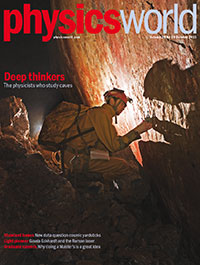By Matin Durrani
It’s amazing the lengths physicists will go to get things done – from building telescopes on the tops of mountains to lowering neutrino detectors to the bottom of the sea and from firing satellites into space to colliding particles in tunnels. We’ve covered all those efforts in
Physics World many times, but there’s one extreme activity that’s been off our radar – until now.
That is the new but little-known field of “speleophysics” – or “the physics of caves” – which we tackle in the cover feature of the October 2015 issue of Physics World magazine. For the small band of researchers who brave the journey underground, being a speleophysicist is almost the perfect job. Armed with helmets, ropes, torches and boots, they’re able to combine their love of physics with a fascination for the nether world – and experience the thrill (and danger) of caving, too.
Caves are pretty much the last parts of the Earth that have not yet been explored. Questions range from how underground caves get sculpted into the shapes we see today to how they will grow and evolve in the future. There are also practical matters at stake, including the role caves play in shifting water underground as part of the water cycle.
If you’re a member of the Institute of Physics (IOP), you can get immediate access to this article in the digital edition of the magazine on your desktop via MyIOP.org or on any iOS or Android smartphone or tablet via the Physics World app, available from the App Store and Google Play. If you’re not yet in the IOP, you can join as an IOPimember for just £15, €20 or $25 a year to get full digital access to Physics World. The article is also available online.
For the record, here’s run-down of the rest of the issue.

• Graphene superconductivity seen – Four independent groups claim to have discovered superconductivity in graphene. However, as Edwin Cartlidge reports, their long-sought results partly contradict one another
• A new era for the old Cavendish? A redevelopment of the University of Cambridge’s historic Cavendish Laboratory could offer new opportunities, as Brian Clegg reports
• Individual recognition – With publications in particle physics containing thousands of
authors, Sahal Yacoob describes how that can pose a problem when a “target culture” is applied to academia
• From wrong to right – The Yang–Mills theory is central to particle physics but why did
something that was once thought to be so wrong prove to be so right? Robert P Crease
investigates
• Unchartered underground – Taking the rigour of physics to the nether world, a handful of scientists are combining their favourite hobby with their day job, exploring how underground caves form, evolve and move water from one place to another. Stephen Ornes reports on the emerging field of “speleophysics”
• Gisela Eckhardt and the Raman laser – Gisela Eckhardt was one of the early pioneers in laser physics, discovering the principle behind the Raman laser in 1962. Valdas Pasiskevicius, Richard Mildren and David Burman tell the largely unknown story of her life – and the challenges she faced as a woman in physics
• Not-so-standard candles – The discovery in the 1990s that the expansion of the universe is accelerating relied on the assumption that type Ia supernovae could all be calibrated to have the same brightness as each other. But as Matthew R Francis reports, new evidence shows that these objects do in fact come in two previously indistinguished varieties
• A physicist’s sense of beauty – Philip Ball reviews A Beautiful Question: Finding Nature’s Deep Design by Frank Wilczek
• The wealth of nations – March Buchanan reviews Why Information Grows: the Evolution of Order, from Atoms to Economies by César Hidalgo
• The Master’s route – A physics Master’s degree provides multiple pathways to successful (and fun) careers, but is it for you? Alaina G Levine weighs up the pros and cons
• A unit for social cyclists – In this month’s Lateral Thoughts, John Evans unveils his new beer unit for bikers
Trackback: Physics World | Covington Research Group
Trackback: The October 2015 issue of Physics World is out now – MyPhysNet